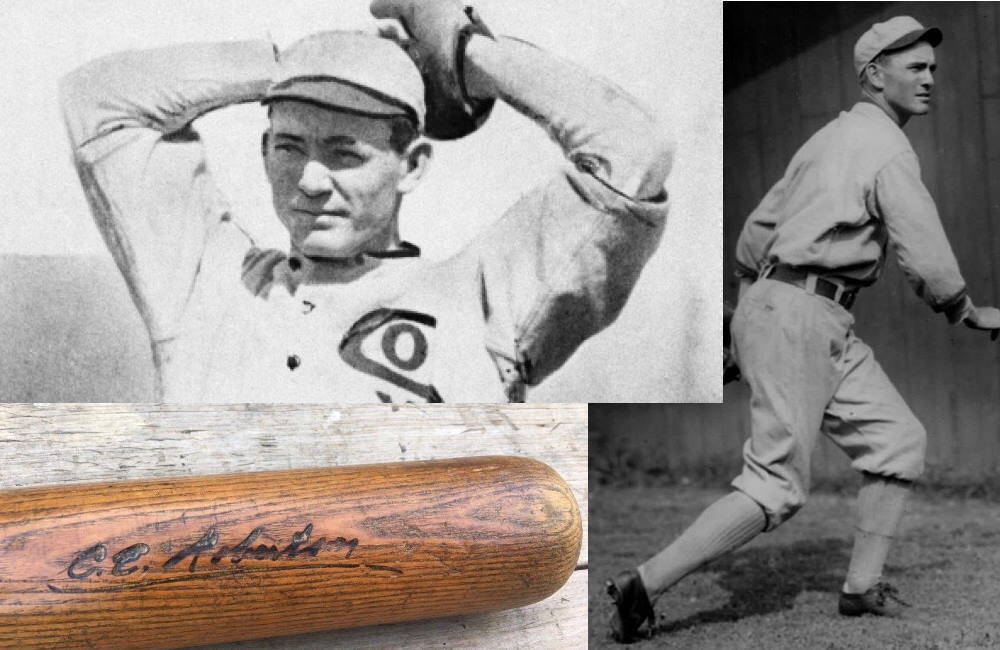An average pitcher most of his career, Charlie Robertson is one of many great stories in baseball about an “average” player unexpectedly performing at an all-time great level. Robertson’s claim to fame is that he pitched the fifth perfect game in baseball history in just his fourth start in the majors. It also was the first perfect game pitched on the road.
Until April 30, 1922, Robertson showed few signs of this kind of greatness. Nor did he show it after that day. But on that spring day, pitching for the Chicago White Sox at Navin Field against the Detroit Tigers, Robertson achieved perfection with battery mate Ray Schalk.
Charlie Robertson’s Early Life
Robertson was born Jan. 31, 1896 in tiny Dexter, Texas, north of the Dallas-Fort Worth metroplex and just south of the Red River and the border with Oklahoma. He was the eighth of nine children born to Mathias and Nancy Robertson, farmers who had moved to Texas from Tennessee.
He graduated from Nocona High School in 1915 and enrolled in Austin College, in Sherman, Texas, to study for the ministry. He played baseball, basketball and football at Austin College, where he graduated in 1918. He also started playing with a Western Association team in Sherman, where he was seen by a scout from the White Sox.
He played minor league ball in Mineral Springs, Texas, and for the Minneapolis Millers in the American Association. He joined the U.S. Army during World War I, interrupting his career. But after his service, the White Sox called him up in 1919 to play in the majors.
The Black Sox
Robertson briefly played on the team that threw the 1919 World Series against the Cincinnati Reds in the infamous “Black Sox” scandal. In May of that season, the White Sox called up rookie pitchers for a series against the St. Louis Browns, a team dwelling at the bottom of the standings. Robertson fared poorly, giving up five hits and two runs in two innings.
Biggest Scandals in Baseball History
The White Sox sent Robertson back to Minneapolis, where he stayed until the 1922 season. However, his brief time with the White Sox gave him another notation in the baseball records. When Robertson died in 1984, he was the last living player from the 1919 Chicago White Sox team.
Charlie Robertson’s Perfect Game
Called back to the White Sox in 1922, Robertson started the season pitching two innings of relief, then pitched six innings for a win and a complete game in a 7-3 win against the Cleveland Indians.
Clearly, Robertson improved quickly, but no one could have foreseen what happened on April 30. Visiting Navin Field in Detroit, Robertson took on a mighty Detroit Tigers team led by Ty Cobb, Bobby Veach and Harry Heilmann.
The lineup ended up hitting the ball out of the infield just five times. One of those proved notable, however. Veach hit a line drive toward left field, where an overflow crowd stood on the field. But the crowd parted at the last second, allowing Johnny Mostil to make a diving catch.
Cobb provided another interesting dimension to the game. In 1922, Cobb both managed and played with the Tigers. He complained several times during the game that Robertson had doctored the ball with grease or oil. However, the American League checked balls used in the game and determined Cobb’s accusations had no merit.
Six Facts About Ty Cobb & His Career
Another interesting aspect of the game is Schalk, the catcher who called the game. He caught four no-hitters in his career. A fantastic defensive catcher known for his ability to work with different types of pitchers, Schalk also has the career record for double plays by a catcher (217) and led the league in fielding percentage eight years.
After The Perfect Game
Robertson threw only the fifth perfect game in history. The four men who came before him were Lee Richmond of the Worcester Worcesters (1880), John Montgomery Ward of the Providence Grays (1880), Cy Young of the Boston Americans (1904) and Addie Joss of the Cleveland Naps (1908).
After Robertson, no pitcher threw a perfect game until Don Larsen of the New York Yankees in Game 5 of the 1956 World Series against the Brooklyn Dodgers.
Don Larsen Early Life and MLB Career
Robertson pitched very well the rest of the way in 1922. He took a no-hitter against Boston into the eighth inning in June and threw a shutout against Cleveland in September. But he also proved erratic in other games, and his career after 1922 never matched that first season.
Robertson eventually went to the St. Louis Browns in 1926 and the Boston Braves in 1927 and 1928 before leaving the majors for good. After two minor league seasons in Milwaukee, Robertson moved back to Texas and became a successful pecan broker in Fort Worth.
He later said that people should “just forget my name. It was long ago.” But his amazing accomplishment is something no baseball fan will ever forget.


Leave A Comment